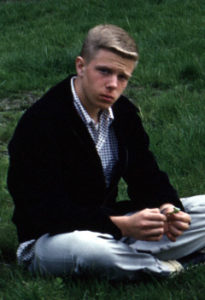The following is from Frank da Cruz’s family history, which contains more memories of living in Frankfurt.
Frankfurt High School

and “Quonset” huts (Silver City)

My brother and I went to the American Army schools — 9th-11th grade for me, Frankfurt High School; elementary school for Dennis. The FHS student body was 900 and included kids like me who walked to school, kids from farther away who arrived in Army buses each day, kids from even farther who lived in the dorm all week but went home on weekends, and kids from REALLY far away like Moscow or Damascus (children of diplomats in places where there were no American schools), who stayed in the dorm all semester. Although 900 sounds small to a New Yorker, it was far too much for the original 1954 building so we also had some “Quonset huts” for the overflow (strictly speaking these were Butler Buildings; real Quonset huts are half-cylinders, but it’s the same idea: prefab temporary buildings made of corrugated metal that can be erected in a few hours).


When I started school in the middle of the 9th grade, it was quite shock. Instead of all white kids like in Virginia, there were Black kids, Puerto Ricans, Hawaiians, Mexicans, Filipinos… and even the white kids were from all over, with every kind of background and accent. Plus people were from all social classes from aristocracy (children of ambassadors or generals) to dirt-poor. It was the complete opposite of my junior high school in Arlington, where everybody was exactly the same: white, middle class, and Virginian.
Some of the FHS kids in 9th grade were hoodlums like in Blackboard Jungle, with leather jackets and collars turned up and ducktails and switchblades but there was never actually any fighting, although my friend Joe Caranci always spent Geography period carving things into his desk with his switchblade and one day when the teacher said something about it, he cut off the teacher’s necktie and threw his briefcase out the window (that was my only Blackboard Jungle class). And yes, there was a Geography class; in those times everybody learned what all the countries in the world were, and something about them.


In reality, it was an excellent school, and the best thing about it was that if you did well in class, there was no social stigma as there was in Virginia. Consequently I got high grades the whole time I was there and had good relationships with many of my teachers, for example Miss Costello, my Latin teacher for two years who acted like a Marine drill sergeant but who was, in reality, a sweetie. Or Miss Rotter who taught AP English and encouraged me to write down any crazy thing that came into my head. I could do that and still be a cool guy. She was also the Radio Club adviser in 1960-61.

To top off the differences from “back home”, there were interracial couples… This was at the exact same time as the huge uproar in Virginia — in Central Point, not far from where I had lived — about the Lovings (a white man and black woman who married and were prosecuted for it), that went all the way to the Supreme Court. Honestly, we all felt so lucky not to have to worry about any of that… Imagine, living in a diverse community with no racial barriers in the late 1950s and early 60s. We knew how precious a gift this was; we lived in a virtual paradise safe from all the ugliness and brutality of our own country.

In 9th and 10th grade I was friends with a girl named Carolyn Parker. We sat next to each other in class; I helped her with her homework (she didn’t really need help, it was like a game). We just enjoyed each other’s company; she was very sweet and soft spoken. But that was 1959-1960 and it simply didn’t occur to us to see each other outside of school, or if it did, we were probably both thinking about how our parents (or in my case, just the one) would react. Plus we were both pretty shy. She “rotated” before my junior year which was when I started to have a social life. But I still remember her. Speaking of rotating, I quickly realized that another big difference between a military base and everywhere else I had ever lived is how easy it is to make friends. Because kids are so diverse, there wasn’t the kind of cliquishness I recall from my junior high school in suburban Virgina. And because nobody stayed in the same place more than two or three years, military brats grew up learning how to make friends rapidly and how to be openminded and honest and not play games. I never felt more comfortable with people in my life than I did there, and never had so many friends, not before, not since.
Another interesting facet of life as a kid on a military base is how the parents are so conscious of rank: who’s more important than who, who can socialize with who, who can go to which club (Officers, EM, or NCO)… whereas the kids instinctively rebelled against all that and we all developed a healthy antiauthoritarian streak. For example if a General found out his daughter was dating a Sergeant’s son he would almost certainly order her to break it off and that would only make the relationship stronger.

Meanwhile, there were endless facilities on the base for service members and their families. The Post Exchange (PX, center in the photo) was like a department store that sold clothing, records, books, pots and pans, etc, (and of course, transformers) at no markup or even subsidized, in recognition of the low military salaries. The Commissary (right of the PX in the photo) was like an American supermarket for food shopping, also nonprofit and subsidized. The Snack bar (left) was a huge cafeteria featuring approximately the same fare as a Burger King or IHOP. Behind these buildings was a gas station where gas was 10 cents a gallon. Scattered all over the base (it wasn’t a fenced-in base, just buildings and neighborhoods all over the city) were countless smaller snack bars, field houses, clinics, athletic fields, running tracks, dispensaries, clubs, and so on. Barracks for soldiers were fenced in, however; they were called Kaserne since most of them were old Wermacht barracks with swastikas chiseled off the gates (Marlene Dietrich: “Vor der Kaserne, vor der großen Tor…” – Lili Marlene).
Medical care was free and universal, school was free and excellent, and housing was heavily subsidized. Ordinary working people of all ranks could live modest, comfortable, and relatively secure and stress-free lives without being millionaires and billionaires. Our parents (or more often than not, just our fathers) did their 40-hour-a-week jobs (and we did ours by going to school), and the government took care of us. No wonder we liked it so much over there, it was Socialism!



Aside from that I don’t remember much about 9th grade, it was only a few months. In 10th grade, Bob Engs was pretty much my main outside-of-school friend. Bob was a year older but we had the same birthday. He was also a year ahead of me in school and president of his class, a super-achiever. He lived far away in the industrial city of Höchst, about two hours away by trolley*, dominated by the huge Höchst AG chemical plant that spewed out toxic black smoke, the air was always thick with it; in those days if you took a color picture of Höchst it would still come out grey. The chemical plants employed thousands of Turkish “Gastarbeiter” under horrible conditions, we never saw them because they weren’t allowed to go into town. My dad was scandalized about Bob, but said it was OK for me to have Black friends as long as we were in Frankfurt, but not in Virginia. My brother’s best friend was also Black. My parents were pretty impressed I could navigate the trolley system from city to city, negotiating the hair-raising transfer from the #17 to the #11 at the free-kill zone in front the Hauptbahnhof.
The Engs family returned to the USA at the end of the 1959-60 school year, ending up in Fort Eustis VA, near Newport News.
* Mary Frances Keller ’61, now Mary Fran Archer, who made the trip every day, says 30 minutes.

